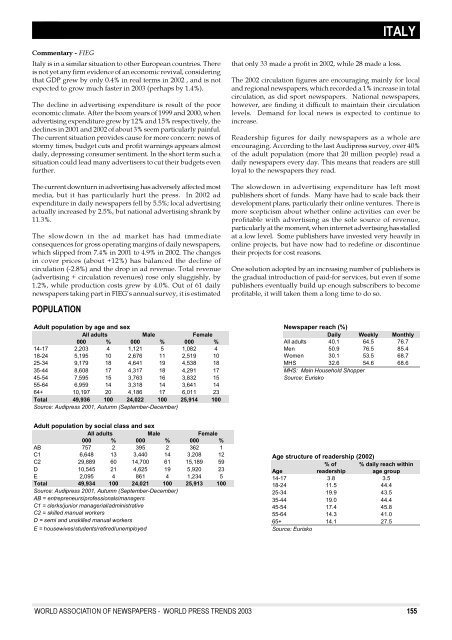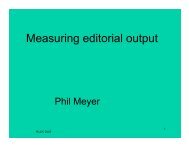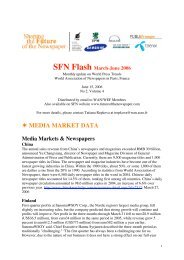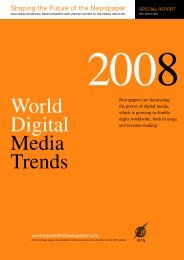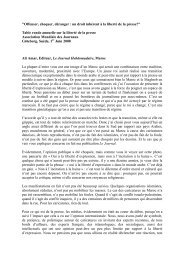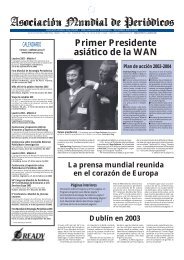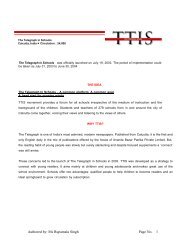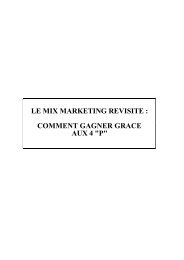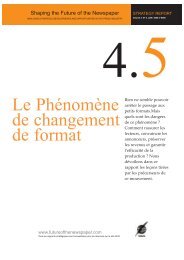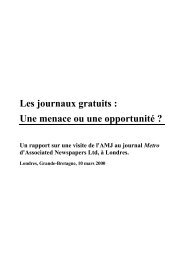WORLD PRESS TRENDS - World Association of Newspapers
WORLD PRESS TRENDS - World Association of Newspapers
WORLD PRESS TRENDS - World Association of Newspapers
Create successful ePaper yourself
Turn your PDF publications into a flip-book with our unique Google optimized e-Paper software.
ITALY<br />
Commentary - FIEG<br />
Italy is in a similar situation to other European countries. There<br />
is not yet any firm evidence <strong>of</strong> an economic revival, considering<br />
that GDP grew by only 0.4% in real terms in 2002 , and is not<br />
expected to grow much faster in 2003 (perhaps by 1.4%).<br />
The decline in advertising expenditure is result <strong>of</strong> the poor<br />
economic climate. After the boom years <strong>of</strong> 1999 and 2000, when<br />
advertising expenditure grew by 12% and 15% respectively, the<br />
declines in 2001 and 2002 <strong>of</strong> about 3% seem particularly painful.<br />
The current situation provides cause for more concern: news <strong>of</strong><br />
stormy times, budget cuts and pr<strong>of</strong>it warnings appears almost<br />
daily, depressing consumer sentiment. In the short term such a<br />
situation could lead many advertisers to cut their budgets even<br />
further.<br />
The current downturn in advertising has adversely affected most<br />
media, but it has particularly hurt the press. In 2002 ad<br />
expenditure in daily newspapers fell by 5.5%; local advertising<br />
actually increased by 2.5%, but national advertising shrank by<br />
11.3%.<br />
The slowdown in the ad market has had immediate<br />
consequences for gross operating margins <strong>of</strong> daily newspapers,<br />
which slipped from 7.4% in 2001 to 4.9% in 2002. The changes<br />
in cover prices (about +12%) has balanced the decline <strong>of</strong><br />
circulation (-2.8%) and the drop in ad revenue. Total revenue<br />
(advertising + circulation revenues) rose only sluggishly, by<br />
1.2%, while production costs grew by 4.0%. Out <strong>of</strong> 61 daily<br />
newspapers taking part in FIEG’s annual survey, it is estimated<br />
that only 33 made a pr<strong>of</strong>it in 2002, while 28 made a loss.<br />
The 2002 circulation figures are encouraging mainly for local<br />
and regional newspapers, which recorded a 1% increase in total<br />
circulation, as did sport newspapers. National newspapers,<br />
however, are finding it difficult to maintain their circulation<br />
levels. Demand for local news is expected to continue to<br />
increase.<br />
Readership figures for daily newspapers as a whole are<br />
encouraging. According to the last Audipress survey, over 40%<br />
<strong>of</strong> the adult population (more that 20 million people) read a<br />
daily newspapers every day. This means that readers are still<br />
loyal to the newspapers they read.<br />
The slowdown in advertising expenditure has left most<br />
publishers short <strong>of</strong> funds. Many have had to scale back their<br />
development plans, particularly their online ventures. There is<br />
more scepticism about whether online activities can ever be<br />
pr<strong>of</strong>itable with advertising as the sole source <strong>of</strong> revenue,<br />
particularly at the moment, when internet advertising has stalled<br />
at a low level. Some publishers have invested very heavily in<br />
online projects, but have now had to redefine or discontinue<br />
their projects for cost reasons.<br />
One solution adopted by an increasing number <strong>of</strong> publishers is<br />
the gradual introduction <strong>of</strong> paid-for services, but even if some<br />
publishers eventually build up enough subscribers to become<br />
pr<strong>of</strong>itable, it will taken them a long time to do so.<br />
POPULATION<br />
Adult population by age and sex<br />
All adults Male Female<br />
000 % 000 % 000 %<br />
14-17 2,203 4 1,121 5 1,082 4<br />
18-24 5,195 10 2,676 11 2,519 10<br />
25-34 9,179 18 4,641 19 4,538 18<br />
35-44 8,608 17 4,317 18 4,291 17<br />
45-54 7,595 15 3,763 16 3,832 15<br />
55-64 6,959 14 3,318 14 3,641 14<br />
64+ 10,197 20 4,186 17 6,011 23<br />
Total 49,936 100 24,022 100 25,914 100<br />
Source: Audipress 2001, Autumn (September-December)<br />
Newspaper reach (%)<br />
Daily Weekly Monthly<br />
All adults 40.1 64.5 76.7<br />
Men 50.9 76.5 85.4<br />
Women 30.1 53.5 68.7<br />
MHS 32.6 54.6 68.6<br />
MHS: Main Household Shopper<br />
Source: Eurisko<br />
Adult population by social class and sex<br />
All adults Male Female<br />
000 % 000 % 000 %<br />
AB 757 2 395 2 362 1<br />
C1 6,648 13 3,440 14 3,208 12<br />
C2 29,889 60 14,700 61 15,189 59<br />
D 10,545 21 4,625 19 5,920 23<br />
E 2,095 4 861 4 1,234 5<br />
Total 49,934 100 24,021 100 25,913 100<br />
Source: Audipress 2001, Autumn (September-December)<br />
AB = entrepreneurs/pr<strong>of</strong>essionals/managers<br />
C1 = clerks/junior managerial/administrative<br />
C2 = skilled manual workers<br />
D = semi and unskilled manual workers<br />
E = housewives/students/retired/unemployed<br />
Age structure <strong>of</strong> readership (2002)<br />
% <strong>of</strong> % daily reach within<br />
Age readership age group<br />
14-17 3.8 3.5<br />
18-24 11.5 44.4<br />
25-34 19.9 43.5<br />
35-44 19.0 44.4<br />
45-54 17.4 45.8<br />
55-64 14.3 41.0<br />
65+ 14.1 27.5<br />
Source: Eurisko<br />
<strong>WORLD</strong> ASSOCIATION OF NEWSPAPERS - <strong>WORLD</strong> <strong>PRESS</strong> <strong>TRENDS</strong> 2003 155


